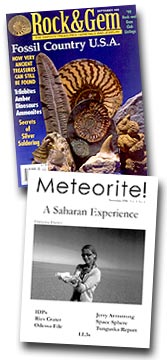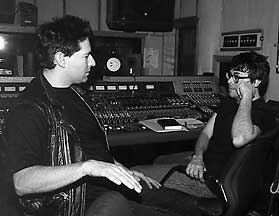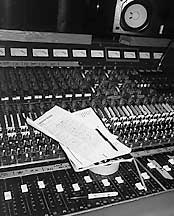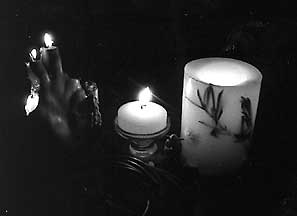|
1980 We were rarely bored during the
Boston years, Lach and I.
After all, we had thousands of young college students to use as fodder,
and our own strange and anarchic three piece band — The Aliens —
for entertainment. Like most teenage rockers we were full of enthusiasm
(read: arrogance) over our band which we, very sensibly, considered to
be the best band in Boston and therefore, most likely, the best band in
all of Massachusetts. On those rare evenings when we weren’t corrupting
young female liberal arts students, or having parties broken up by the
Boston Police Department we liked to sit in Lach’s tiny corner apartment
on Buswell Street, drinking beer, smoking, and playing The Radio Game.
The Radio Game involved turning off the lights, burning some candles
and incense and — no doubt somewhat intoxicated — slowly rolling
the radio dial from one end of the broadcast band to the other. Each time
we found a station, we’d leave the dial there for the duration of
the song then playing. In a city like Boston, with its many independent
and college radio stations, there was always a good chance of discovering
some new and interesting band. And the mood of the room changed with the
arrival of each new station. We might hear a cut by Boston’s own
Robin Lane and The Chartbusters, or a jazz piece, a movement from a classical
symphony, some punk rock, or some heavy metal.
Once, a fortunate turn of the dial took us to a place full of raunchy
but melodic music, with a hypnotic and mysterious beat, complete with
lyrics which mentioned Dr. Strange (and we were dedicated comics fans.)
“What the hell is this?” I asked Lach. “This is great.”
“I don’t know, but I wish I’d written it.”
It was The Bongos’ cover of Marc Bolan’s “Mambo Sun,”
from their recently-released first album. From that day we were Bongos
fans, and Drums Along The Hudson became part of the soundtrack
of our time in Boston, along with Jim Carroll’s Catholic Boy,
and The Clash’s Sandinista!
1987 After years of living in New York, and years
playing with Lach in Proper Id and other bands I moved to Hoboken —
The Bongos’ home — which boasted a vigorous independent music
scene that The Bongos had helped create. I was thrilled to meet Bongos
guitarist James Maestro, who still lives in town, and to become part of
the Hoboken scene that revolved around Maxwell’s and The Beat ’n’
Path.
1997 Lach and I continued to work in New York and
New Jersey, playing in Hoboken as well as Manhattan, and we put in a couple
of years as one third of Lach and The Sextet Offensive where, for the
first time, acoustic guitars became an important part of the band. But,
when Lach took us into Bisi Studios in Brooklyn we seemed unable to truly
capture our unusual live sound.
The group disbanded and Lach — as he always does — continued
to give me regular reports of his ever-expanding plans, ranging from solo
tours to founding a record company (which he did.)
Lach phoned me one afternoon, early in 1997, at the publishing company
where I was freelancing. Tired of looking for the right label deal, he
had decided to go to a different studio and make a CD for his new label
— Fortified. By chance he’d met former Bongos frontman Richard
Barone at the Sidewalk Café, and given him a rough tape. Richard
called a few days later to say that he was listening to the tape and was
interested in working on a studio project. It was likely that former Television
drummer Billy Ficca would be part of it, and Lach already had a short
list of potential bassplayers which included veteran New York scenester
and Washington Squares founder, Tom Goodkind, who had also produced our
first CD, Contender.
“Do you think this is really going to happen?” I asked Lach.
“I mean this is such a fantastic line-up with Billy Ficca and Richard
Barone.”
But Lach was concerned that Tom was too busy to work on the project, and
so he was also considering asking Bob Dylan’s current bassplayer.
These guys were heavy hitters, and I was starting to feel maybe a little
out of my league, but I knew I had to be a part of this record.
“Look, Lach,” I said. “I really want to do this record.
After all the years we’ve spent working together, we’ve never
come up with the definitive recording, and this could be it. I would love
to work with Barone. In fact, I would be thrilled to work with Barone!
I want you to know that I’m very, very interested in doing this.”
“But I thought you wouldn’t want to do it. You said you were
tired of playing out,” he replied.
“I’m tired of playing small East Village bars, yes, but I’m
always ready to go back into the studio with you.”
Days passed, and I started chewing my fingertips, horrified at the thought
that Lach would be working with the leader of the Bongos and that I might
not be a part of it. Eager to be involved, I exploited my position as
band archivist by compiling demos and live cuts from our entire career
together, and mailing them to Richard.
“Geoff grew up in London and has a real Clash/Jam bassplaying style,”
Lach had told Richard. He liked the sound of that a lot, and on one glorious
day Richard telephoned me personally to invite me to on board.
Our early meetings took place at Sidewalk, and also in a cozy Chelsea
bar close to the rehearsal studios that we would use for pre-production.
It was exciting and a little scary to be playing in a secluded studio
with a drummer as famous as Billy; and Richard — one of our heroes
— sitting against the wall with a file folder full of notes, watching
everything we did with intense concentration, writing down comments and
making suggestions.
A few years earlier, during the Contender sessions, Lach and
I had indulged our passion for Star Wars by re-enacting scenes
from the movies in between takes. This greatly amused our producer, Tom,
who would leave the tape running without telling us. One segment (“I
hope the old man got that tractor beam out of commission, or this is gonna
be a real short trip. Okay hit it!”) even made it onto the disc,
immediately before the raucous “Hard Times.”
Not much changes, and so as we moved into the recording phase of Blang!
Lach and I spent down time in the studio doing C3-PO and Han Solo routines.
And then Star Wars action figures started to appear in the studio,
and they weren’t ours! It also happened that the re-released special
edition of the Star Wars trilogy was in the cinemas at the time,
and on numerous afternoons Richard would appear, beaming, after an early
visit to the Ziegfeld to see Empire Strikes Back or Return of
the Jedi one more time. We’d somehow managed to get involved
with one of the few people in the world who was an even bigger Star
Wars fan than we were. An assemblage of action figures, which included
Yoda and the Emperor, and those weird robots whose names I can never remember,
populated the mixing console for the duration of the sessions, along with
bubble gum cards and other paraphernalia which Richard would produce on
a daily basis.
|






